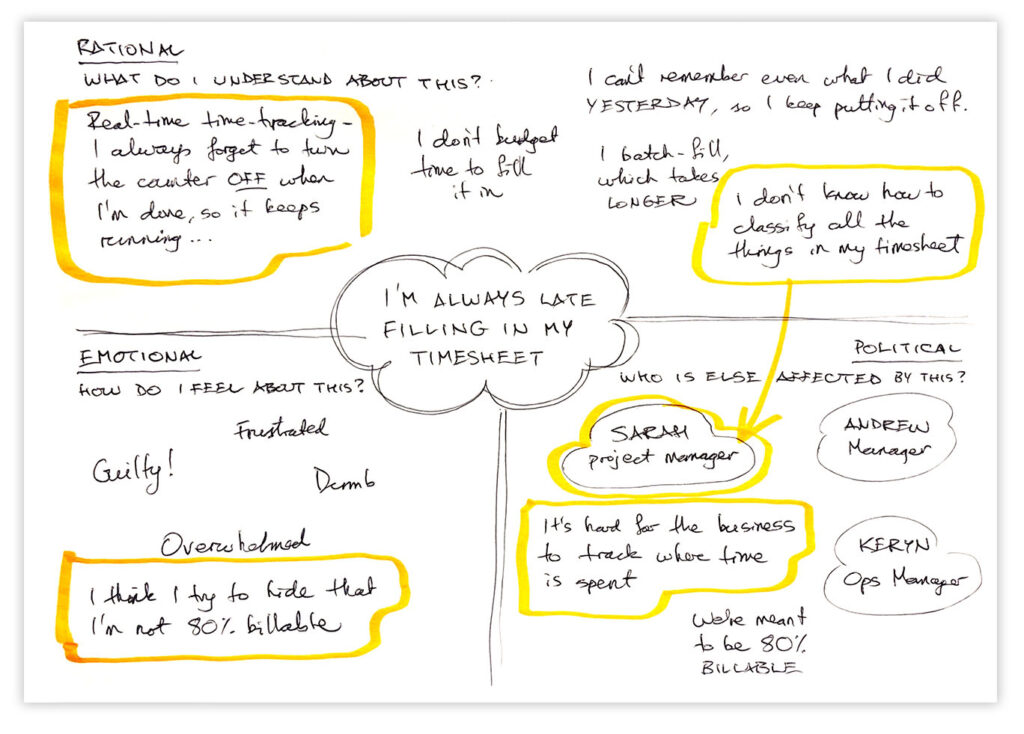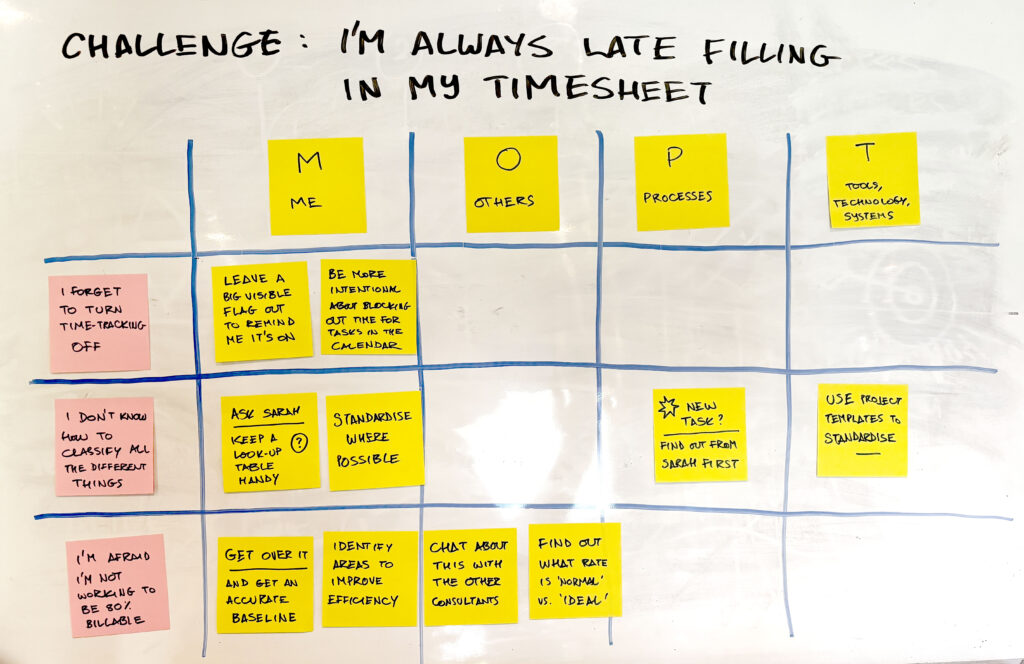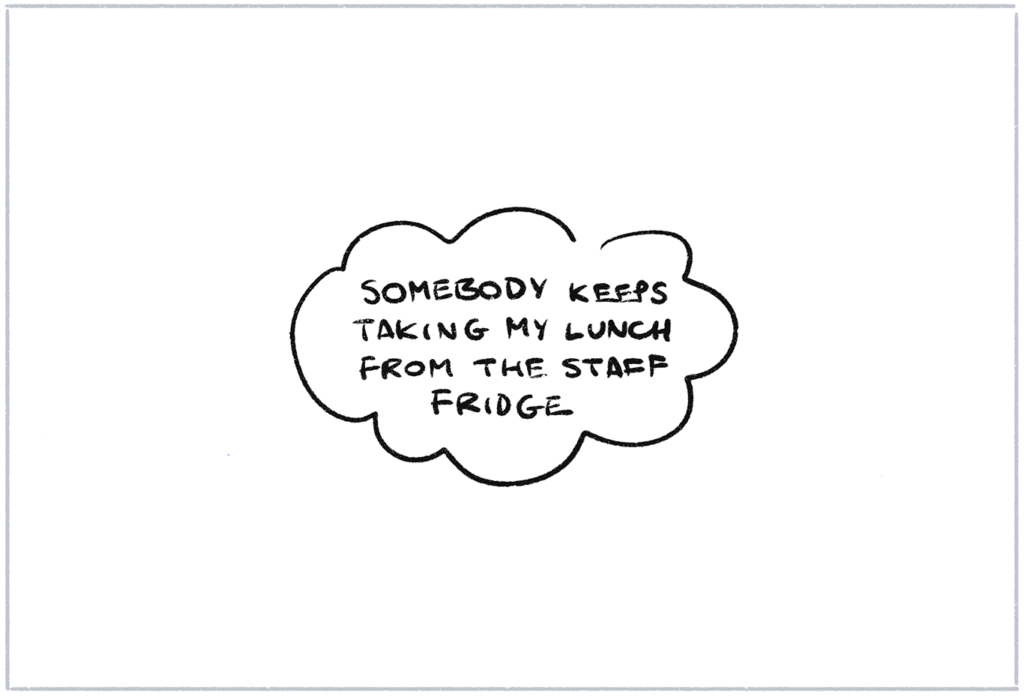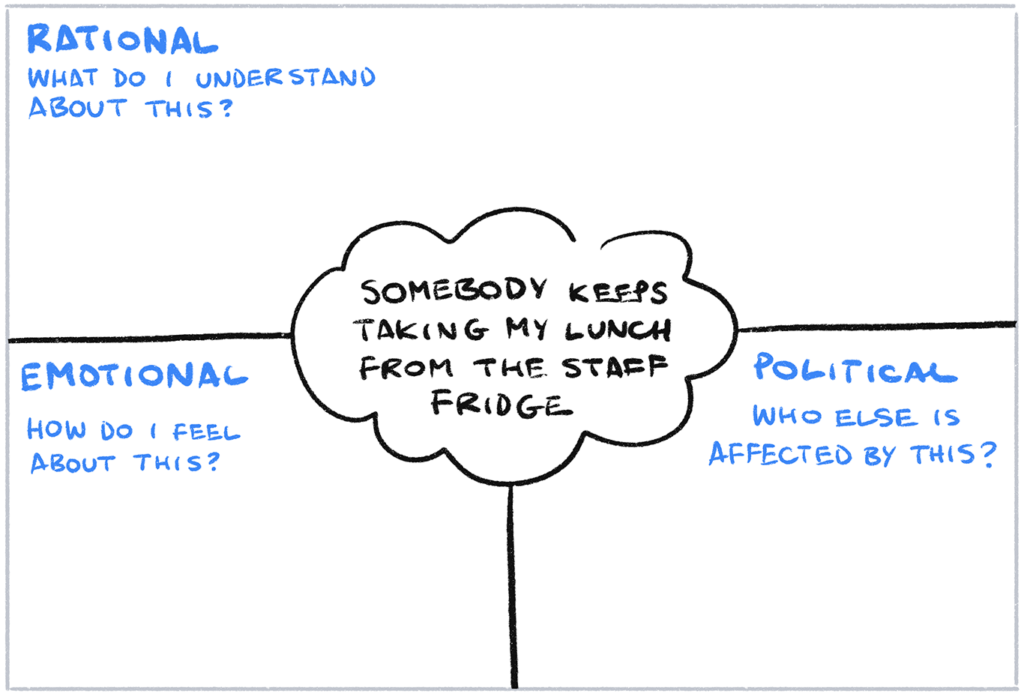In the last post, we looked at an easy way to sketch out various aspects of a problem, according to three parts:
- Rational – What do I understand about this? (objective, facts and data)
- Emotional – How do I feel about this? (subjective, feelings and stories); and
- Political – Who else is affected by this? (associative, connections and systems)
These three lenses give us a more structured way to approach and better understand a problem space.
Step 1: look for clues
So where does the MOPT come in? I’ll get to that. Firstly, you get the sheet you sketched before, where you jotted down notes and pictures about the rational, emotional and political parts of your problem. Then you go back over it, looking for clues that could give rise to ideas to solve that problem.
For this example, I’m going to change my initial problem to: I’m always late filling in my timesheet. Here you’ll see I’ve circled a few clues:

You might notice from my sheet that the two things I’ve circled in the rational space are like sub-problems, or problems within the larger problem. That’s good to highlight. You might also find connections that you hadn’t seen before. Notice the arrow in mine, where I’ve connected the fact that I don’t know how to classify all the things I do in the timesheet, with Sarah the Project Manager, who certainly does. This will lend itself nicely to an idea for a solution.
If you’re lucky, you might also find the odd valuable insight. One of the things I wrote in the political part of my sheet is that it’s hard for the business to track where time is spent. Afterward it occurred to me: if the business knows what projects we have on, and who is occupied on each project, then it should already have a pretty good idea of where people’s time has been spent, rather than starting each week blank.
Understanding MOPT
At the heart of this method is the now-famous innovation question: “How might we [solve this problem]?“. ‘How might we’ as an approach was invented by Procter and Gamble, and popularised by companies like IDEO and Google. I’m a big fan, because it’s a great way to have a positive mindset about any problem, and it moves ideas in more useful directions.
The things is, the ‘we’ in ‘How might we…’ is sometimes left out of that ideas-generation mindset. In other words: ‘we’ are the ones coming up with ideas, but ‘we’ may not be in the final solution. And that’s where MOPT comes in. MOPT stands for:
M = Me
You – either you individually, or the collective ‘you’ as the team taking on this challenge – might indeed be the one to solve the problem. Often those closest to the problem itself are the best qualified to solve it. For example, Kathy Bowles was a nurse (now at University of Pennsylvania School of Nursing) who was concerned that patients were five times more likely to be readmitted to hospital than those who received proper post-acute care when needed. This drove her to spearhead RightCare Solutions, where she and her team designed an end-to-end software solution simplifying the post-acute care referral process.
O = Others
Sometimes it’s clear that you (or those you work with) are not the ones to solve a challenge, but you can alert, support, and encourage others who certainly can, with some initial thinking about your perspective on the challenge.
P = Processes
When we try to come up with solutions to challenges, sometimes we think the solution lies in something completely new, ‘blue sky’, or radical, while the solution(s) may well lie in improving the humble day-to-day processes everyone takes for granted. Toyota has always made a name for itself with its focus on process optimisation. Its Toyota Way puts great emphasis on Lean principles of minimising waste (muda) and kaizen (continuous improvement).
T = Tools, technology and systems
This is often the first ‘idea territory’ that people reach for when generating ideas. Tools! Apps! A new website! Any solution you come up with will typically sit within a system of other solutions. It’s worth zooming out a bit, and noticing other adjacent parts of whatever system the challenge is a part of. Whatever you think of McDonalds, Ray Kroc – the man responsible for turning it into the global fast-food juggernaut it is today – can be credited with tons of great system improvement ideas. By focusing on systems improvement, he was able to streamline and scale not only how the kitchens and menu processing ran, but all other parts of the business including quality control, partner relations, and real estate tactics.
Step 2: draw up a MOPT table
Now that we have our heads around the idea of different territories of solutions, we can move on to step 2. We transfer our initial challenge over to a new piece of paper (or whiteboard, or area on an online innovation space like Miro), and draw up a table, with a row for each clue.
There are four other columns, for Me, Others, Processes and Tools:

Now, either by yourself or as a team, you can tackle each cell of the table separately, and come up with a range of ‘How might…’ questions, depending on the clue, e.g. “How might I improve this so that I can recall everything I do?” or “How might I solve this so that I don’t even need to recall everything I do?”
I really like this because straight away I’m going to get more ideas than I otherwise would have, because I’m setting up all these different cells to fill. And like all good brainstorming, not all the ideas need to be practical yet; it’s always good to go for quantity first, and see if some ideas lead to other ideas.

There’s not a lot of space in those little squares, so treat each cell as a placeholder for your thinking, a springboard to another piece of paper, or another part of the whiteboard. Here’s where I got to with mine:
Note how a couple of cells in my example above just didn’t apply, and that’s fine. Mixing written notes and pictures is also fine. What this does is it arranges our thinking spatially, rather than just as a list… or with no form at all. Once you fill your MOPT table, you can go back over it and pick out the ideas that are most resonant and relevant.
How was it for you?
Go on, give it a go, you might be surprised by the insight this reveals to you. If you do give it a try, let me know how it goes, and if you think it could be improved upon.

